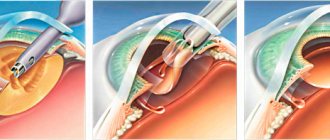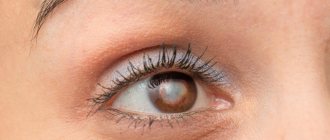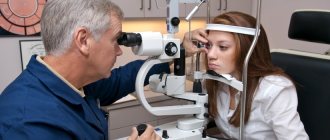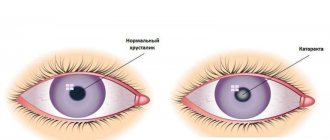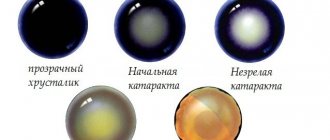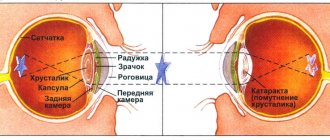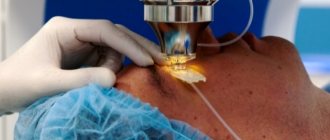What is cataract
Most often, as a result of age-related changes in the body, cloudiness appears in the lens and vision deteriorates. Symptoms are caused by a change in the ability of the damaged organ to transmit and refract light. Cataracts at the initial stage are characterized by mild symptoms. Destruction begins with the appearance of protein deposits on the lens. In patients with hypermetropia, a temporary improvement in vision is possible, which eliminates the need to wear corrective glasses. They can read and see small objects. The main risk factors that provoke clouding of the lens are old age, hereditary predisposition, and being female. It has been noted that people with brown eyes get sick more often than those with light eyes.
Symptoms of senile cataracts
The clinical picture of age-related cataracts differs depending on the stage and form. The following symptoms may be a reason to consult an ophthalmologist:
- blurred vision;
- clouding of the pupil;
- development of “night blindness”;
- floating spots before the eyes;
- blurred contours of surrounding objects;
- transition of farsightedness to myopia;
- double vision of visible objects;
- increased sensitivity to light.
The closer to the nucleus of the lens the opacities are, the more severe the symptoms will be. Senile cataracts can be suspected if there are difficulties in selecting lenses for the patient.
Reasons for the development of the disease
Pathological processes are triggered when age-related changes appear in the visual organ - the older the person, the larger the size of the lens. Over time, it thickens and becomes heavier. Also, damage of a symmetrical or asymmetrical nature occurs as a result of dysfunction of the endocrine system, long-term use of a certain group of medications, or the presence of toxins in the body.
Factors leading to the development of cataracts:
- regular exposure to ultraviolet rays or infrared radiation;
- genetic and congenital abnormalities;
- premature birth (damage to the baby's retina);
- long-term treatment with corticosteroids;
- penetrating eye injuries;
- increased blood sugar levels;
- chronic iridocyclitis;
- incomplete removal of lens masses during extracapsular extraction.
Main symptoms
At the initial stage of cataracts, there is no significant decrease in visual acuity, and other signs do not appear in any way. Therefore, patients do not rush to see an ophthalmologist, because they do not even assume that the disease has already begun to progress. The reason for a visit to the clinic later becomes the noticeable effect of cataracts on the eyeball, when vision begins to deteriorate. At this stage, clouding is detected in the outer parts of the lens; the central part is rarely affected.
Symptoms of eye pathology and the degree of their severity depend on the size of the clouding. If any signs appear, you should immediately visit a specialist:
- doubling of objects before the eyes;
- black dots, rainbow circles;
- the formation of a halo around the light source;
- colors are difficult to distinguish;
- vision decreases in low light.
People with age-related myopia experience improved vision. This is caused by swelling of the lens and a corresponding increase in its ability to refract light. Late stages are characterized by vision problems due to thickening of the lens and changes in refractive indexes.
Is it possible to stop cataracts at an early stage?
The disease most often affects patients over 50. Early age-related cataracts account for about 10% of all cases - the older the person, the higher the risk of developing pathological changes in the lens. The category of people over seventy years of age with visual problems due to cataracts is about 46%. Ophthalmologists consider protein deficiency of the eyeball and metabolic disorders to be factors causing eye dysfunction. But these are not the only reasons, there are others:
- alcohol abuse, excessive smoking;
- eye injury;
- thyroid function disorder;
- high blood sugar;
- Down syndrome;
- burn of the mucous membrane of the eye, often obtained in the active sun, if you do not wear sunglasses;
- glaucoma;
- retinal detachment;
- congenital lens anomalies formed in the embryonic period;
- anemia;
- inflammatory process in the vessels of the eye;
- systematic exposure to elevated temperatures, for example, due to professional activity;
- genetic predisposition;
- acute or chronic inflammation of the periphery of the vascular system;
- severe poisoning;
- skin diseases;
- high myopia.
People who experience symptoms of cataracts should consult an eye doctor. It is impossible to prevent cataracts. In the initial stages, therapeutic drug treatment is prescribed. Despite the fact that many argue that medications will slow down pathological processes and allow surgery to be postponed. In practice, the effectiveness of such drugs has not been proven.
Cataracts, unfortunately, cannot be treated conservatively. It can only be eliminated surgically. Phacoemulsification is considered the most effective - the affected lens is removed through a microincision, and an implant - an intraocular lens (IOL) - is placed in its place. This is the only way to restore clarity of vision to an elderly person.
How to treat cataracts in old age?
The only radical method of treating cataracts at any age is surgery. Drug therapy slows the progression of the pathology, but does not restore lost vision. Therefore, doctors usually recommend surgery to remove the lens. The operation can be carried out in several ways:
- Phacoemulsification. This is the most effective and safe operation in which the lens is destroyed by exposing it to ultrasonic waves and replaced with an implant. The operation is performed under local anesthesia and lasts no more than 20 minutes.
- Extracapsular extraction. The nucleus of the clouded lens is removed under a special microscope through a microscopic cut and replaced with an artificial lens. Not the entire lens is removed, but only the affected part. The disadvantage of this operation is significant injury to the eyeball.
- Intracapsular extraction. Using a special device, the lens and capsule are frozen to a metal tip and then removed through an incision. This operation is highly traumatic, so it is used only in extreme cases.
Phacoemulsification of cataracts
Indications for surgery
Surgical treatment of cataracts in old age is carried out if the following indications exist:
- mature, overripe cataract;
- swelling cataract;
- lens luxation;
- development of complications;
- pathology of the fundus.
Surgery to remove a clouded lens is recommended to be performed at the initial stage of development of the pathology, when the outcome is most favorable. Surgery for cataracts in older people is not performed if the patient suffers from the following diseases:
- diabetes;
- inflammation of the eyeball;
- eye infections;
- hemophilia;
- cardiac ischemia;
- neoplasms in the area of the visual organs;
- exacerbation of chronic pathologies.
The need for surgery, as well as the method of surgery, is determined by the attending ophthalmologist.
Postoperative period
After cataract surgery, the patient can usually go home within a couple of hours. Healing of the eyeball occurs within 2-4 weeks, the final restoration of the eye occurs within 3 months. For the first 7-10 days, older people should wear a special bandage on the sore eye to prevent infection of the eye. During the month of the rehabilitation period, it is necessary to instill anti-inflammatory drops into the operated eye, as well as apply special gels to promote wound healing.
During the postoperative period, the following recommendations must be followed:
- Avoid getting hot steam in your eyes;
- control eye pressure;
- avoid active movements;
- avoid lifting heavy objects;
- Wear sunglasses in bright light;
- refuse to carry out thermal procedures.
Nutrition for cataracts in old age should be correct and balanced.
After 4-6 months, the suture is removed, after which vision is restored by 90-100%.
Treatment of the initial stage of cataracts
Non-surgical methods of combating initial cataracts include drug treatment, taking vitamin complexes and various diets. But you need to understand that if a cataract is diagnosed, it will develop and this process cannot be stopped.
The conservative method involves the use of various biologically active substances that act as blockers of eye lens abnormalities. One part of them is available in the form of drops. The other is in the form of injections, administered intramuscularly.
Complexes of vitamins and minerals are aimed at normalizing metabolic processes in the eyeball. They necessarily contain taurine and adenosine, as well as other elements that have a beneficial effect on the lens. What the doctor may prescribe:
- "Facovit." The medicine is sold in pharmacies in the form of drops and is intended to improve metabolism and block an increase in the area of lens clouding.
- Quinax.” In the case of cataracts, this drug is most often prescribed by an ophthalmologist. It eliminates symptoms well, prevents oxidation of the lens, and improves metabolism.
- "Taufon". Stabilizes metabolic processes and stimulates regenerative processes in the body. Protects the eye from pathogenic microflora, which can cause infection and other complications.
- "Catarax". The medication prevents the spread of clouding and destruction of the lens by slowing down protein reactions (protein is the main component of the eyeball). Drops trigger active metabolism, accelerating the regenerative function of the visual organ. Allowed for use during pregnancy and lactation.
It is not recommended to use medications on your own initiative. The type and dosage should be prescribed exclusively by the attending physician, taking into account the individuality of each case and contraindications.
Treatment of initial cataracts also includes diet. It consists of limiting foods and dishes high in fat - they increase cholesterol in the blood. You need to eat red fish, black currants, and spinach. These products contain a lot of vitamins C, E, and omega-3 fatty acids that are beneficial for vision. They delay the development of eye diseases and have a beneficial effect on the entire body.
Age-related cataracts: prevention and treatment
Relevance
According to the World Health Organization (WHO), there are 253 million people in the world with visual impairment, of which 36 million are blind. Often (in 80% of cases) visual impairment occurs in patients of the older age group - people aged 50 years and older, and in the future, as expected, their significance and scale in the context of the global aging of our planet's population will increase even more. One of the WHO development strategies is to ensure an effective and accessible system of eye care. Global Action Plan for Universal Access to Eye Health 2014–2019. aims to reduce preventable visual impairment as a global public health problem and ensure access to rehabilitation services for those affected by it. The global goal was to reduce the prevalence of preventable blindness and visual impairment by 25% by 2021 from the 2010 baseline [1]. Cataracts are the leading cause of blindness and the second leading cause of visual impairment in the world. More than 80% of patients with cataracts live in low-income developing countries. In 80% of cases, visual functions reduced due to cataracts can be restored after surgery, but not everywhere patients have the opportunity to receive surgical treatment [2]. The results of the study by R. Acosta et al. showed that the prevalence of cataracts in Europe, the USA and Australia is very significant - from 5% to 30% [3]. The prevalence/incidence of cataracts in Iran is equal to that of some other Asian countries such as Taiwan (10.7%) and Singapore (9.7%) and higher than that of countries such as Indonesia (2.2%) and Nepal (5.3%) [4]. Despite scientific advances in the fight against cataracts between 1990 and 2010, the increase in the incidence of cataracts in the world is 1% among men and 3% among women. In Russia, the incidence of cataracts is estimated at 320.8 per 100 thousand population annually, with age-related cataracts accounting for more than 90% of all cases [2]. In our country, about 500 thousand cataract extraction operations are performed per year [5].
Risk factors for developing cataracts
Among the risk factors for the development of cataracts, age must first be noted, since it has been established that after 65 years, half of the population has a certain degree of lens opacification, although this may not lead to visual impairment. The risk of cataracts increases with long-term smoking, diabetes mellitus lasting >10 years, bronchial asthma or chronic bronchitis, and cardiovascular diseases [6, 7]. The Blue Mountains Eye Study showed that patients with fasting blood glucose >6.0 mmol/L had an increased risk of 10-year incidence of cortical cataracts compared with patients with fasting blood glucose <6.0 mmol/L, hazard ratio ( RR) and 95% confidence interval (95% CI) were 1.79 (1.25–2.57). This study also highlighted that a 1.0 mmol/L increase in fasting glucose was associated with 5-year progression of posterior subcapsular cataract [1.25 (1.15–1.35)] and 10-year progression of cortical cataract [1, 14 (1.01–1.27)] and nuclear [1.20 (1.01–1.43)] cataracts [8]. Cataract surgery was required approximately 20 years earlier in patients with type 1 diabetes compared to patients without diabetes [9]. A study conducted by S. Theodoropoulou et al. showed that smoking, concomitant coronary heart disease, the presence of ophthalmological diseases in relatives and prolonged exposure to sun significantly increase the risk of cataracts [10]. The influence of such risk factors as a history of trauma or inflammatory diseases of the eye, eye surgeries, long-term use of corticosteroids, exposure to ionizing radiation, race, diet, environmental pollution, composition of drinking water, geographical features, etc. has also been established [11].
Pathogenesis of cataracts
The pathogenesis of cataract development remains poorly understood, despite many years of scientific interest in the causes of this disease. Currently, there are several theories of cataractogenesis. Today, the theory of oxidative stress is recognized as one of the dominant ones. It is known that oxidative stress can result from an imbalance between the formation of reactive oxygen species and cellular antioxidant defense mechanisms. In eye cells, reactive oxygen species can initiate a surge of toxic biochemical reactions, such as peroxidation of membrane lipids and significant damage to proteins, causing aggregation and precipitation of intracellular proteins by changing their configuration, exposing thiol groups that are normally located within the protein structure, methionine oxidation , cysteine. Cataracts are characterized by the formation of high molecular weight protein complexes covalently linked by disulfide bonds [12, 13]. Such protein aggregations lead to the appearance of areas of light scattering, thereby reducing the transparency of the lens. The most important oxidizing agents are free radicals - molecules with unpaired electrons in their outer shell. This unpaired state makes them very unstable and prone to reacting with other molecules. One of the byproducts of lipid peroxidation is malondialdehyde (MDA), whose participation in cataractogenesis is considered due to its ability to cross-link lens fibers, which also leads to a decrease in transparency [14].
Clinical picture of cataract
The initial stage
of the disease usually proceeds for a long time unnoticed by the patient, since it develops slowly, and often small opacities are located outside the optical zone of the lens.
Over time, complaints of a veil before the eyes, floaters, doubling of luminous objects, and increased refraction may be disturbing. The initial stage of the disease is characterized by hydration of the lens - the presence of water gaps between the lens fibers and the accumulation of fluid vacuoles in the subcapsular layers. Subsequently, as the cataract progresses (from several months to decades), the opacities become more intense, the area of their distribution increases, and the optical zone of the lens is also affected. The cataract progresses to the next stage, called immature
, or
swelling
, cataract.
At the same time, visual acuity is significantly reduced, the lens becomes grayish-white, with a pearlescent tint. The stage of immature cataract can also last for quite a long time, after which it passes into the stage of mature
cataract, when opacities affect the entire area of the lens up to its anterior capsule.
Visual acuity drops to light perception with correct light projection. Diffuse gray opacification is visible in the pupil area. Further development of the process leads to a gradual liquefaction of the cortex of the lens with the formation of an opaque milky-white mass ( overripe cataract
), a decrease in the size of the lens, deepening of the anterior chamber and iridodonesis.
Paradoxically, over time, as the whitish mass gradually dissolves, patients may again have objective vision. During the development of cataracts in patients, it is rare, but serious complications
, such as phacogenic glaucoma (phacomorphic - due to an increase in the volume of the lens during swelling and the formation of a relative pupillary block with a narrow angle of the anterior chamber; phacolytic - if, with overmature cataracts, large protein molecules come out of the lens through the altered anterior capsule and, together with macrophages, clog the trabecular filter). If these complications develop, patients require emergency surgery.
Cataract treatment
The only effective treatment for cataracts currently is cataract extraction surgery. It is important to consider that this treatment approach results in significant economic costs. Healthcare costs for cataract extraction surgery vary significantly across European countries, ranging from €318 in Hungary to €1,267 in Finland. The total cost of cataract surgery has a positive correlation with the type of technology used, the amount of working hours and the length of the patient's hospital stay [15]. Performing the intervention on an outpatient basis made it possible to significantly reduce its total cost—by 60% [15]. Currently, the most commonly performed procedure is phacoemulsification of cataracts (PEC) with intraocular lens implantation. However, in the case of FEC on lenses with a high core density, during the operation it is necessary to increase the power and time of exposure to ultrasound to fragment it, which can lead to a significant loss of corneal endothelial cells and the development of endothelial-epithelial dystrophy in the patient. Therefore, in recent years, data have appeared on the advantages of performing this operation with femtolaser assistance (FemtoFEC), used for the formation of corneal tunnels, capsulorhexis, and fragmentation of the lens nucleus [16, 17]. Thus, it has been established that the use of a femtosecond laser makes it possible to achieve a more predictable capsulotomy and an optimal form of capsulorhexis; its use for preliminary fragmentation of the lens nucleus helps to reduce the impact of ultrasound and, as a result, less loss of endothelial cell density. Simultaneous implementation of anterior capsulorhexis, the formation of self-sealing corneal accesses and, if necessary, the implementation of arcuate incisions to correct astigmatism allows one to achieve better functional results [18]. Of great interest is the study conducted by S.V. Shukhaev et al., which assessed the subjective satisfaction of patients with the FemtoFEC operation. The authors noted that despite preliminary detailed explanations of the procedure and warnings about its two-stage procedure with transfer from one operating room to another, many patients considered the operation completed after the first stage and were not prepared for the second stage to follow. Thus, the authors came to the conclusion that the subjective tolerability of the operation is better with classical FEC, which is associated with a two-stage treatment with FemtoFEC. Patients also did not note any benefits in the quality of vision after FemtoFEC [19]. The incidence of cataracts is so high that the surgical approach has proven insufficient to solve this problem. Despite great advances in this field, cataract remains a major public health problem due to a shortage of surgical supplies, especially in developing countries, and an increase in the number of people with cataracts due to aging and population growth. It is important to consider that surgical treatment of cataracts requires high economic costs and can lead to postoperative complications, such as opacification of the posterior capsule, retinal detachment, macular edema, endophthalmitis, rupture of the posterior capsule with prolapse of the vitreous into the anterior chamber, etc. [15]. Studies show that many patients experience anxiety and fear before surgery, which can also lead them to refuse or delay making a decision about the need for surgery. Among the fears of patients, fear of the operation itself, fear of becoming blind, complications during surgery, fear of incomplete restoration of vision, etc. prevail [20]. In addition, since cataract extraction is mainly required by patients of the older age group, it is necessary to take into account the possible coexistence of a whole range of diseases in one patient, and some of them may serve as a contraindication for the operation. In these cases, the ophthalmologist's task will be to prescribe medications that slow down the development of cataracts. The prescription of drugs with antioxidant and metabolic properties seems to be pathogenetically justified. Oftan® Katahrom
(manufactured in Finland, Japan) is a drug with a unique combined composition aimed at slowing the development of cataracts in patients who are not ready for surgical treatment. The adenosine contained in the drug serves as a precursor of ATP and takes an active part in the metabolic processes of the lens, nicotinamide (vitamin PP) stimulates the synthesis of nicotinamide dinucleotide, a cofactor for dehydrogenases, cytochrome C is an antioxidant and plays an important role in biochemical redox processes in the tissues of the eyeball [21 ]. The drug is produced in the form of eye drops and does not require additional manipulations for its dilution. The shelf life of an open bottle is 1 month. at temperatures from 2 to 8 °C, 3 years - in a closed state. The drug is intended for instillation into the conjunctival sac, 1–2 drops 3 times a day, without restrictions on the duration of use. The undoubted advantage of the drug includes its high safety profile: the absence of serious side effects (keratitis, blepharitis), the absence of restrictions on combined use with other ophthalmic drugs (zinc sulfate, etc.), the minimum content of benzalkonium chloride (0.04 mg) [21 ]. Oftan® Katahrom is one of the most well-studied anti-cataract drugs. Its clinical effectiveness was demonstrated in a study by T.N. Lumpova on the example of 67 patients (120 eyes) with a diagnosis of “initial cataract and primary open-angle glaucoma grades I–II, compensated with medication.” All patients were prescribed Oftan® Katahrom, 1 drop 3 times a day. The follow-up period ranged from 1 to 3 years [22]. Most patients noted a subjective improvement in vision without glasses and (or) with glasses by the end of the 1st year of treatment. After completion of the course of therapy, visual acuity remained unchanged in 65 eyes (54%), improved in 16 eyes (13.34%), of which in 6 eyes visual acuity without correction improved by 0.2 (2 eyes) and by 0.4 (3 eyes). The author suggests that these changes occurred due to regression of lens opacities under the influence of Oftan® Katachroma instillations. In 36 eyes (30%), visual acuity still decreased. E.V. Egorova et al. assessed the effectiveness of preventing the progression of age-related cataracts using instillations of the drug Oftan® Katachrom and in combination with the use of ultrasound to enhance the penetration of the drug into the intraocular media [23]. Patients with pseudophakia in one eye and early cataracts in the other were instilled with Oftan® Katachrom alone (group 1 - 90 eyes) or in combination with the use of ultrasound to enhance the penetration of the drug into the intraocular media (group 2 - 50 eyes). After 24 months it was noted that the lens remained transparent in 50.0% of patients in group 1 and in 62.3% of patients in group 2. The authors reliably confirmed the normalization of metabolic processes in the tear fluid, the slowdown of lens opacity, and the preservation of visual acuity, and the use of ultrasound therapy increased the effectiveness of instillations. In the study by G.S. Polunin studied the effect of anti-cataract drugs on various localizations of lens opacities: mainly in the nucleus, in the posterior cortical layers or in the region of the posterior capsule. It was found that instillations of Oftan® Katachroma contributed to the stabilization or reduction of the optical density of the cortical layers of the lens; an improvement in visual acuity in patients with cortical cataracts was observed in 62% of cases [24]. The authors conclude that Oftan® Katachroma is able to improve oxidative and energetic processes in tissues, have virtually no effect on the resorption of opacities of the posterior capsule and at the same time give a positive effect on opacities in the cortical layers of the lens.
Conclusion
Thus, the importance of developing non-surgical approaches to the prevention and treatment of cataracts, taking into account the pathogenesis of this disease, becomes obvious. A balanced diet, rational use of antioxidants and reducing exposure to factors leading to oxidative stress (obesity, smoking, excessive alcohol consumption, excess exposure to ultraviolet radiation) are currently the best measures that can delay the onset of cataract development [15]. To slow down the progression of existing lens opacities in patients who are not ready for surgical treatment, it is advisable to prescribe instillations of anti-cataract drugs, for example, the drug Oftan® Katachrom in the form of eye drops, which is a combination drug with clinically proven antioxidant and metabolic effects, well tolerated by patients of all ages groups, and side effects with its use are extremely rare. Information about the authors: 1 Koroleva Irina Anatolyevna - candidate of medical sciences, ophthalmologist; 2 Evgeniy Alekseevich Egorov - Doctor of Medical Sciences, Professor, Head of the Department of Ophthalmology, Faculty of Medicine. 1 GBUZ City Clinical Hospital No. 15 DZM. 111539, Russia, Moscow, st. Veshnyakovskaya, 23. 2 FSBEI VORNIMU named after. N.I. Pirogov of the Russian Ministry of Health. 117997, Russia, Moscow, st. Ostrovityanova, 1. Contact information: Koroleva Irina Anatolyevna, e-mail: [email protected] . Financial transparency: none of the authors has a financial interest in the materials or methods presented. conflict of interest . The article was received on October 15, 2018. About the authors: 1 Irina A. Koroleva - MD, PhD, ophthalmologist; 2 Eugene A. Egorov - MD, PhD, Professor, Head of Ophthalmological Department. 1 City Clinical Hospital No. 15. 23, Veshnyakovskaya str., Moscow, 111539, Russian Federation. 2 Pirogov Russian National Research Medical University. 1, Ostrovityanova str., Moscow, 117997, Russian Federation. Contact information: Irina A. Koroleva, e-mail: [email protected] . Financial Disclosure: no author has a financial or property interest in any material or method mentioned. There is no conflict of interests. Received 10/15/2018.
Is surgery necessary?
This question worries many patients, but there is no clear answer to it. In most cases, everything is individual. If you have been diagnosed with cataracts, then surgery is inevitable. Moreover, the sooner it is performed, the safer it will be for the eye and it is better not to delay it. For one person, minimal clouding of the lens may not be an indication for surgical manipulation, but for another it may greatly complicate his life and cause discomfort.
After 50 years, the lens stops performing its functions properly - clouding and presbyopia develop. Ophthalmologists at CVH, relying on the opinion of authoritative experts around the world, recommend removing it and replacing it with a high-quality implant - an intraocular lens. Our center also uses the latest PanOptix multifocal lenses.
There is no need to be afraid of surgery. Our clinic is equipped with modern equipment from leading global manufacturers, and our specialists are qualified doctors with extensive experience. The surgical procedure takes only 5 minutes and is completely safe. It is carried out with initial cataracts or even in its absence, to correct poor vision for refractive purposes.
Modern artificial lenses have the same functions as natural ones. The American company Alcon produces the AcrySof IQ IOL. This is a high-quality imitation of a healthy lens, which has the following advantages:
- reduction of optical aberrations;
- vision becomes comfortable and functional in any lighting;
- natural and rapid adaptation to the implant is provided;
- hydrophobic lenses.
There are currently no reported cases of complications or implant failure with PanOptix multifocal IOLs.
Disease prevention
The initial stage of cataracts is not a death sentence; modern cataract removal techniques can restore your vision within a few seconds. Cataracts are associated with age-related changes, so no one can avoid them. But you should still adhere to medical recommendations for a healthy lifestyle:
- protect your eyes from strong and prolonged exposure to ultraviolet radiation by wearing sunglasses with appropriate filters outdoors;
- do not drink alcohol;
- no smoking;
- do not eat harmful foods;
- maintain weight within normal limits, if it is higher, then take measures to lose weight;
- treat hypertension with antihypertensive medications;
- Visit an ophthalmologist regularly.
It is better not to neglect the last point. Only an ophthalmologist will be able to recognize the onset of the disease and prescribe effective treatment. A visit to the doctor is necessary for inflammation of the eye, as well as for regular monitoring of myopia.
Causes of senile cataracts
Clouding of the transparent optical lens in the senile form of cataract is due to the natural aging of the body. With age, the basic substance of the lens changes, its structure becomes denser, and the transparent zones are gradually replaced by areas of opacification.
This age-related process, which directly precedes the development of the disease, is referred to as “phacosclerosis.” It is characterized by compaction of lens fibers and metabolic disorders in tissues. During this period, there are usually no symptoms of decreased vision, so many people do not see a doctor.
Unlike traumatic and some other types of cataract, when opacities affect only one eye, the senile form is characterized by a bilateral process of damage. A person with this disease becomes blind in both eyes, although the degree of clouding on one side and the other may differ.
